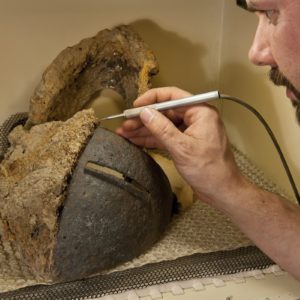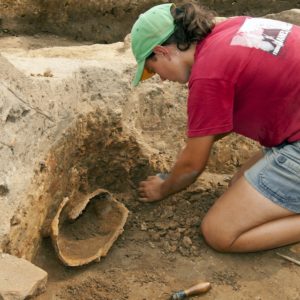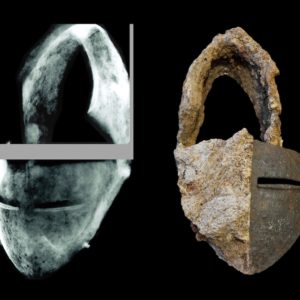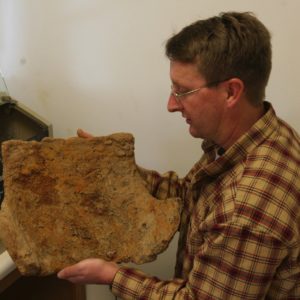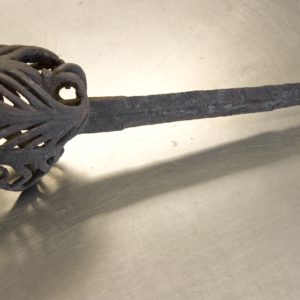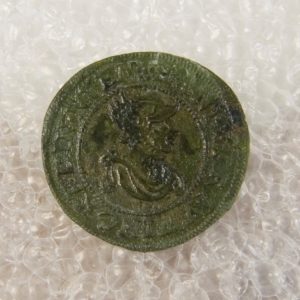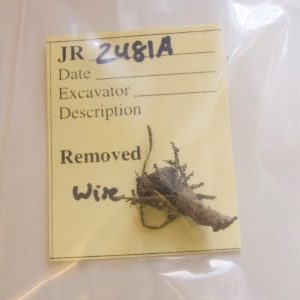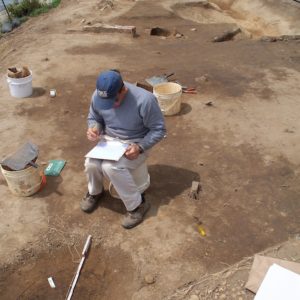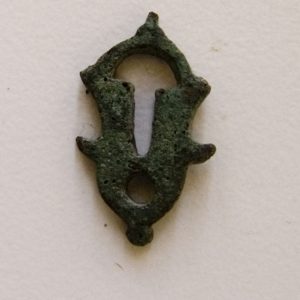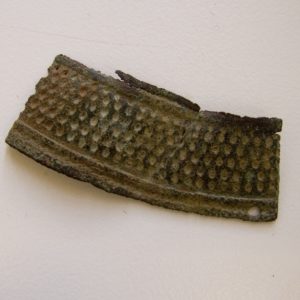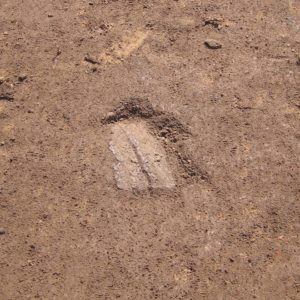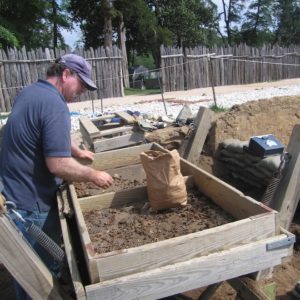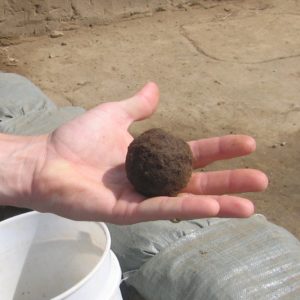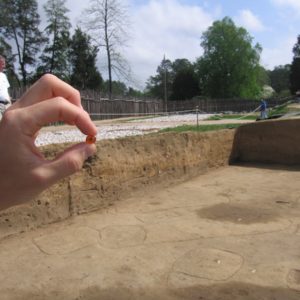The 2008 dig season has begun and the Jamestown Rediscovery team is busy excavating an area near the southwest corner of James Fort. Evidence for a fort-period structure has turned up in the form of five evenly-spaced postholes that parallel the fort’s southern wall. Several more burials have been discovered in an early-17th-century graveyard just feet from the structure. Over 30 graves have now been found in this area. The conservation staff is restoring lost splendor to some spectacular artifacts found during last year’s excavations. Work continues on an iron backplate, a nearly-intact broadsword, and a helmet, all found in a fort-period cellar.
Excavations are currently focused on an area near the southwest corner of James Fort. Many interesting features are turning up, including postholes from a fort-period building, several fort-period graves, postholes from a Confederate gun platform, and pre-contact-period Virginia Indian pottery. Five postholes have been discovered at regular 10-foot intervals that run parallel to James Fort’s southern wall. The postholes are notably uniform in their depth, diameter, and distance from each other. They neatly line up with the fort’s southern wall, evidence that this structure was built while the fort still stood. Because of the postholes’ relationship with other younger features in the area, the archaeologists can tell that this building was indeed a very early fort-period structure. These postholes are part of the building’s northern wall; the other walls have been lost to centuries of river erosion. The building was at least forty feet long. It may have been longer, but any possible further postholes were lost when a late-17-century ditch was dug.
Evidence of another structure—built around 250 years later—has also been discovered in this area of the fort. A series of postholes are the latest in a huge series of features that combine to make up a Confederate fort that was built on the island in 1861. These particular postholes would have been part of a wooden barrier wall that separated an artillery platform from the surrounding earthworks. There are obvious gaps in the posthole pattern that may suggest the locations of the cannons themselves. The fact that the Confederates built the fort unbeknownst to them—on top of where James Fort once stood —has done much to preserve the archaeological remains beneath it. Where the Confederate earthworks placed several feet of soil between James Fort below and the ravages of centuries of erosion and human occupation above, the archaeological footprint of the 1607 fort was largely spared. Elsewhere on the site, plow scars, water pipes and other disturbances have left their mark on the fort’s remains.
More and more burials are turning up in the area. Over 30 graves have now been found near the southwest corner of the fort. These are early fort-period burials, and the hope is that perhaps this means one of the fort’s early churches is nearby. So far, none of the structural features found in the area have given any obvious evidence that they were part of a church.
Virginia Indian pottery is turning up in substantial amounts in this area of the fort, in a context that suggests it is much older than the fort itself. This pottery is further evidence that Virginia Indians lived on the island at times in the centuries preceding Jamestown. At the time of the establishment of James Fort, Virginia Indians did not live there, but used the island as a hunting ground.
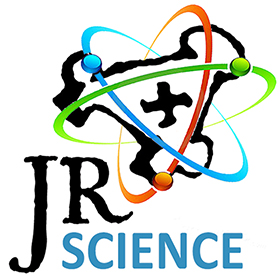 Archaeologists have uncovered the disturbed soil from excavations conducted in the 1950s by Joel Shiner. Shiner found many early colonial features and artifacts as well as substantial evidence for Virginia Indian occupation of the island prior to 1607. His excavations drew him to conclude that James Fort was probably nearby. The discovery of Shiner’s excavations inside the fort shows that he was much closer than he could have imagined.
Archaeologists have uncovered the disturbed soil from excavations conducted in the 1950s by Joel Shiner. Shiner found many early colonial features and artifacts as well as substantial evidence for Virginia Indian occupation of the island prior to 1607. His excavations drew him to conclude that James Fort was probably nearby. The discovery of Shiner’s excavations inside the fort shows that he was much closer than he could have imagined.
The Jamestown Rediscovery conservators have been working on some pretty spectacular artifacts recently. A broadsword found last year in a cellar near the northern bulwark of James Fort has almost been totally conserved. Fully encrusted with rust when it was discovered, the broadsword was rendered nearly unrecognizable by 400 years of exposure to the elements. Careful conservation has restored much of its original appearance, revealing a mostly-intact blade and an intricately designed hilt with a round pommel. Conservation continues on a backplate and a helmet also found last year in the cellar. The conservation team is using air abrasion to gently remove the rust from these artifacts. The helmet is unique to the Historic Jamestowne collection in that it is the first to have an intact faceplate. Two eye slits and several breathing holes give a menacing human visage to an otherwise solid iron mask. A neck protector has been fused above the faceplate by rust and would have normally rested below it. The section that protects the top of the head is missing.
Other artifacts now being conserved include a Krauwinkel jetton with the likeness of Mercury on the obverse, a jeweler’s draw plate, several decorative insect-like objects, and a keyhole escutcheon. The Krauwinkel jetton was minted in Nuremberg in present-day Germany. Jettons were counting coins and this one features the likeness of the Roman god Mercury. A draw plate found in the cellar would have been part of a jeweler’s kit. Draw plates were used to create wires of different shapes to fashion into necklaces and other jewelry. This particular plate has three different shapes, a half-moon, a six-pointed star, and a four-pointed star. Wire would have been drawn through the plate, sometimes with the aid of a lubricant, in order to obtain the desired shape. Chemical analysis of residue found in one of the draw plate’s holes indicates that copper wire was once used with this tool. Two curious decorative insect-like objects made out of copper wire also excavated during last year’s cellar dig are now being conserved. Lastly, a copper keyhole escutcheon discovered in a 17th-century well is being conserved. Escutcheons are primarily decorative accents around a keyhole, but can also be used to protect the lock mechanism and the locked object from wear.
related images
- Senior conservator Michael Lavin uses an air abrader to remove rust from the helmet.
- Mary Anna excavating the close helmet in 2007
- An x-ray of the helmet and the helmet in a partially-conserved state
- Conservator Dan Gamble works on an iron backplate.
- A conserved broadsword found last year in a fort-period cellar
- A Krauwinkel jetton bearing the likeness of the Roman god Mercury
- One of the insect-like wire decorations found in the cellar area
- Line of posts from excavated building
- Archaeologist Don Warmke creates a record of one of the postholes of the fort-period structure.
- The keyhole escutcheon found in a 17th-century well.
- A flattened out section of a thimble. This one is similar to another thimble in the Historic Jamestowne collection.
- Draw plate
- The helmet after more further removal
- A sherd of Virginia Indian pottery in situ
- Archaeologist Dan Smith sifts through soil looking for small artifacts.
- A cannonball found near the southwest corner of the fort
- A carnelian bead found near the southwest corner of the fort



